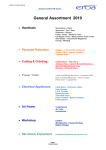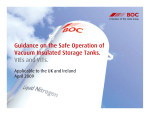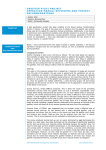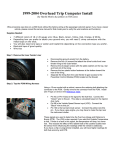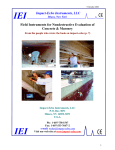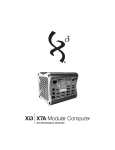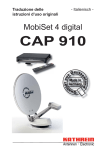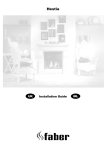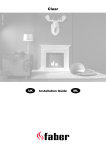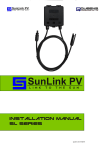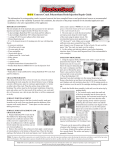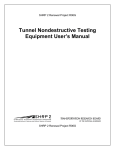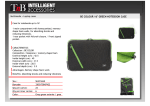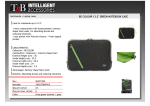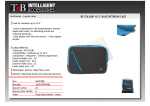Download Technical data sheet CSE Standard
Transcript
Technical data sheet CSE Standard Robust epoxy resin for injection work Structural repair of dry, damp and wet cracks Overview Type Two-component, solvent-free, low viscosity epoxy resin Features Workhorse resin and centerpiece of the CSE injection resin line-up To be used in conjunction with the ChemCo Injection Process (CHIP) Force-transferring filling of dry, damp and wet cracks Superior flow characteristics allow low pressure injection and avoid the disadvantages of conventional high pressure methods Usable above 8°C and suitable for cracks as narrow as 0.1 mm, penetration into tributary cracks down to 0.01 mm Does not embrittle, high resilience, resistant to creep Applications Structural repair of cracks, voids, interstices and delaminations in concrete, masonry and wood Filling of porous and honeycombed concrete and grout Adhesive bonding of steel and fibre-reinforced plastic (external reinforcement) Anchoring bolts, dowels and rebar into concrete, masonry and stone Certifications / Approvals Conformity with the European norm DIN EN 1504-5 Agreement (Übereinstimmung) with the German norm DIN V 18028 Included in the list of the German Federal Highway Research Institute (BASt) as an approved crack injection material Meets the requirements of type IV applications of the US norm ASTM C 881 as well as AASHTO M 235 Surface Concrete, masonry, stone, steel, wood and FRP Application temperature 8°C - 35°C Product introduction Description CSE Standard is a two-component, low viscosity, structural epoxy adhesive specifically designed for low pressure injection using automatic meter, mix and dispensing equipment suitable for the CHIP system. Primary uses include the structural repair of cracks, voids, interstices and delaminations in concrete, masonry, stone, sealed wood and FRP; filling of porous and honeycombed concrete and grout; adhesive bonding of steel and fibre-reinforced plastic (external reinforcement); anchoring bolts, dowels and rebar into concrete, masonry or stone. Applications requiring material thickness in excess of 6 mm may be facilitated by pre-placing aggregate in the void. CSE Standard bonds to dry, damp and wet substrates. The components do not contain volatile organic compounds (VOC's) and are solvent-free. Features The physical properties of the product allow its use in applications requiring resistance to creep and stress relaxation, maintenance of mechanical properties at high ambient temperatures, high load bearing strength and excellent adhesion under adverse application conditions, e.g. cold, wet concrete. Unlike many other high modulus epoxy adhesives, CSE Standard cures to a tough, resilient polymer and has excellent load transfer capability. Depending on the application temperature, the exceptional substrate wetting ensures penetration and filling of cracks with a width starting at 0.1 mm on the surface and tributary cracks down to 0.01 mm. It has a convenient 2:1 (by vol.) mixing ratio and employs special colorants for contrasting component color. Limitations The minimum application temperature is 8°C. For application temperatures near or below 8°C or when very narrow cracks are encountered, consider use of CSE Low Temp. For application temperatures above approximately 30°C, consider use of CSE High Temp. The maximum in-service temperature should not exceed 10°C below the glass transition temperature in bonding applications subjected to substantial and sustained shear stresses that may cause creep. Installed thickness in excess of 6 mm may require the use of pre-placed aggregate to dissipate heat generated during the cure process. Do not add solvents or otherwise thin this material. Packaging Standard package size is 15 gallons (2 x 5 gallons of A, 1 x 5 gallons of B) Storage Minimum three years in unopened original containers between 15°C and 32°C in a dry place without direct sunlight. Remixing of components may be required upon long-term storage. Chemical resistance CSE Standard has excellent resistance to a wide range of commonly encountered chemicals including acids and bases, aircraft and automotive fluids, petroleum fuels, cutting oils, etc. It has limited resistance to hydrocarbon solvents. Performance is a function of the specific chemical and concentration, ambient and solution temperatures, exposure times and housekeeping procedures. Color The standard color of the mixed components is dark purple. A clear amber color is also available. Application Preparation Surface: Prepare cracks by blowing clean with oil-free compressed air or by flushing clean with an appropriate cleansing solution as required to remove foreign substances and contaminants. Surfaces may be dry, damp or wet. Surfaces adjacent to cracks or other areas of application shall be cleaned of dirt, dust, oil, efflorescence, paint or other foreign material which may be detrimental to establishing a bond of the sealing material prior to epoxy injection. Placing of ports: The B30 KEMKO surface mount epoxy injection port is recommended for most applications. It offers superior adhesion to the epoxy seal so port blow-off is minimized. Integral with the port is a plug for port closure. In case of no direct access to the crack, the B32 KEMKO inset (drillset) injection port is designed for a pre-drilled hole of a few mm depth. It has a sloped flange that will hold it in the hole in any orientation without additional adhesive. It is inserted into the hole, constructed for toughness and extra flexibility and will e.g. withstand hammer blows. Ports: The entry ports shall be located on the crack line surface. Port setting shall be done in such a manner as not to plug the crack at that location and prevent subsequent adhesive injection. For the repair of through-cracks entry ports shall be placed along a crack in intervals not less than the thickness of the structure at that location. The entry ports for the repair of cracks which do not entirely penetrate the structure shall be spaced in a technically reasonable manner. Seal: The sealing material shall have adequate strength to hold injection ports in place and the capability of withstanding the pressure during adhesive injection and cure. Removal of seal shall be possible without undue alteration of the surface. Besides quick-setting cement, a suitable injection seal is the product KEMKO 046 QuikSEAL, a two-component epoxy paste adhesive designed for sealing cracks in preparation for repair with the CHIP. It bonds to dry and damp substrates. Also suitable is the product KEMKO 136 StripSEAL, a twocomponent polyurea paste adhesive designed for sealing cracks in preparation for repair with the CHIP. It was specifically designed for quick and easy manual removal from the repaired crack and is for use on dry substrates. Please consult the respective technical data sheets for further information. Seal application: The surface seal material shall be applied to the face of the crack between and around the entry ports with a thickness of about 0.3 cm and a width of about 2.5 cm. For through-cracks the surface seal shall be applied on both faces. Adhesive injection shall not be started before the seal material has had adequate time to acquire sufficient strength to withstand injection pressures. For the specific application conditions and possibilities please refer to the respective technical data sheets. Mixing CSE Standard may only be used with automatic meter, mix and dispenses application equipment suitable for the CHIP. The mix ratio of component A and component B is 2:1 by volume. It needs to be regularly checked that the equipment used mixes the components accurately and delivers only thoroughly mixed material. Please take note of the user manual of the machine in use. Workable time Depending on the application temperature, the mixed material inside the mix head of the pump used within the CHIP should be purged at least every two to seven minutes (e.g. in case of a temporary stop of the injection work, in case of problems to inject material into the crack, etc.). The workable time ranges from 2 min at a temperature of 35°C, 7 min at 21°C to 22 min at 8°C. Injection Injection of the epoxy adhesive shall begin at the lowest entry port and continue until the adhesive emerges from the next adjacent (higher) port. As soon as the adhesive emerges from the adjacent port, injection shall be stopped, the port sealed and the injection transferred to the adjacent port. In case of horizontal cracks, injection should be started at one end of the crack and then from one port to another until the other end of the crack has been reached. The process of injection - waiting for emergence of adhesive from the next adjacent port, sealing of the injection port and continuation of injection in the adjacent port - shall continue until the crack is filled. The process of injection may be modified to the extent that injection at the original port may be continued after emergence of adhesive from the adjacent port by sealing that port and waiting for emergence at the next port or ports. This modification of the regular injection procedure may be used if the injection pressure does not substantially increase, the port seals remain in place and no leaks become apparent. If port to port travel of the injection adhesive is not indicated, the work shall be stopped and remedial action shall be taken which may require resetting of surface ports. Such work shall only be done after authorization from the responsible engineer. Cure After the crack has been completely filled, the injection adhesive shall be given sufficient time to cure (generally at least eight hours, depending on the curing conditions a significantly longer period may be necessary) to a state which allows removal of the seal without any adhesive run-out or smearing of the adjacent surface. Finishing All surface seal material and injection adhesive runs or spills shall be carefully removed from the surface, if so directed by the responsible engineer. The face of the repaired crack shall be finished flush with the adjacent surface and indentations or protrusions caused by the placement of entry ports shall be removed. If required, paint, coating or other substances may be applied subsequently. Technical data (mixed components) Viscosity (ASTM D 2393) 1355 mPa.s (8°C), 350 mPa.s (22°C) Gel time (ASTM D 2471) 35 min (10°C), 14 min (22°C) Tens. strength (EN ISO 527) 57.8 N/mm² Elongation (EN ISO 527) 1.80% Elastic modul. (EN ISO 527) 3805 N/mm² Glass transition temperature (EN 12614) 47.8°C Non-volatile matter (EN ISO 3251) 99.8% Adhesion by tensile bond strength (EN 12618-2) Dry: 3.6 N/mm²; wet: 3.1 N/mm² Compressive yield strength (ASTM D 695) 113.7 N/mm² Compressive modulus (ASTM D 695) 3923.1 N/mm² Bond strength (moist substrate, ASTM C 882) 2 days: 21.4 N/mm²; 14 days: 26.9 N/mm² Further information Clean up of machine and equipment All tools and equipment must be cleaned before the mixed material cures. Cleaning can be facilitated with a solvent such as acetone or heavy-duty detergents. Cured material may be removed from equipment and tools by soaking in an epoxy stripper. Safety notices GENERAL NOTE: THIS TECHNICAL DATA SHEET DOES NOT ACCOMPANY THE PRODUCT WHEN SOLD. PLEASE TAKE NOTE OF THE HAZARD NOTES, SAFETY RULES, FIRST AID PROCEDURES AND DISPOSAL INFORMATION IN THE MATERIAL SAFETY DATA SHEETS AND ON THE CONTAINER LABELS. GISCODE: RE1 Legal notices IN THIS DOCUMENT OR ANY OTHER FORM OF COMMUNICATION BY THEIR RESPECTIVE EMPLOYEES, CHEMCO SYSTEMS INC AND CSE SALES AG MAKE NO EXPRESS WARRANTY WITH RESPECT TO THE RESULTS OF ANY USE OF THIS PRODUCT. NO IMPLIED WARRANTIES, INCLUDING AND NOT LIMITED TO AN IMPLIED WARRANTY OF MERCHANTABILITY OR AN IMPLIED WARRANTY OF FITNESS FOR A PARTICULAR PURPOSE IS MADE WITH RESPECT TO THIS PRODUCT. PLEASE REFER TO THE DECLARATION OF PERFORMANCE FOR PRODUCT PERFORMANCE INFORMATION. NO LIABILITIES FOR PERSONAL INJURY, LOSS OR DAMAGE RESULTING FROM THE USE OF THIS PRODUCT IS ASSUMED. THE RESPECTIVE APPLICATOR IS RESPONSIBLE FOR COMPLIANCE WITH ALL APPLICABLE LAWS AND REGULATIONS FOR THE USE OF THIS PRODUCT. CSE SALES AG RESERVES THE RIGHT TO DISCONTINUE THE PROVISION OF THE PRODUCT DESCRIBED HEREIN AT ANY TIME AND WITHOUT PRIOR NOTICE. ALL DATA AND INFORMATION IN THIS DOCUMENT ARE BASED ON LABORATORY TESTS WHICH ARE SUBJECT TO A CERTAIN VOLATILITY. RESULTS OBTAINED IN THE ACTUAL USE OF THIS PRODUCT MAY BE DIFFERENT. Contact For general or project specific information please contact: CSE Sales AG Huenefeldzeile 2 12247 Berlin Germany T: +49.30.77207851 F: +49.30.7741096 [email protected] http://www.csesales.de Version: 2, 08/2015





